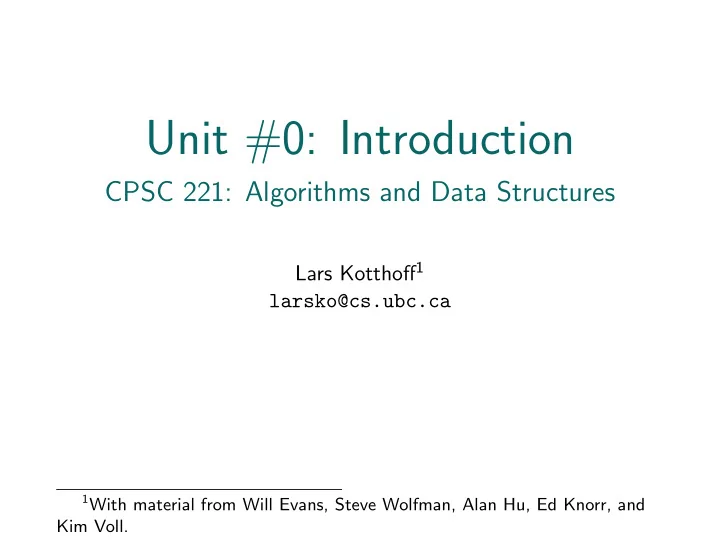

Unit #0: Introduction CPSC 221: Algorithms and Data Structures Lars Kotthoff 1 larsko@cs.ubc.ca 1 With material from Will Evans, Steve Wolfman, Alan Hu, Ed Knorr, and Kim Voll.
Course Information Instructor Lars Kotthoff, larsko@cs.ubc.ca , ICCS X569 Course website http://www.ugrad.cs.ubc.ca/~cs221 Office hours TBD TAs see website
Textbooks
Course Policies No late work; may be flexible with advance notice 10% Labs 15% Programming projects ( ≈ 3) 15% Written homework ( ≈ 3) 20% Midterm exam 40% Final exam Must pass the final and combo of labs/assignments to pass the course.
Collaboration You may work in groups of two people on: ▷ labs ▷ programming projects ▷ written homework You may also collaborate with others as long as you follow the rules (see the website) and acknowledge their help on your assignment. Don’t violate the collaboration policy.
Course Mechanics ▷ Web page, http://www.ugrad.cs.ubc.ca/~cs221 ▷ Piazza, https://piazza.com/ubc.ca/winterterm22015/cpsc221 ▷ UBC Connect, www.connect.ubc.ca ▷ Labs start next week, (roughly) every week ▷ Programming projects will be graded on Linux and g++ (CS ugrad machines)
Help ▷ other students ▷ Piazza ▷ TAs, instructors ▷ the interwebs (e.g. Stackoverflow for programming questions, see https://stackoverflow.com/help/how-to-ask )
Your degree is your responsibility.
Algorithms and Data Structures ▷ What is an algorithm?
Algorithms and Data Structures ▷ What is an algorithm? High-level, language-independent description of step-by-step process for solving a problem.
Algorithms and Data Structures ▷ What is an algorithm? High-level, language-independent description of step-by-step process for solving a problem. ▷ What is a data structure?
Algorithms and Data Structures ▷ What is an algorithm? High-level, language-independent description of step-by-step process for solving a problem. ▷ What is a data structure? Specialized format for organizing and storing data efficiently.
Algorithms and Data Structures ▷ What is an algorithm? High-level, language-independent description of step-by-step process for solving a problem. ▷ What is a data structure? Specialized format for organizing and storing data efficiently. Particular algorithms may work (better) with particular data structures.
Observations ▷ programs manipulate data ▷ programs process, store, display, gather data ▷ data can be text, numbers, images, sound ▷ programs must decide how to store and manipulate data ▷ choice affects behaviour of the program ▷ execution speed ▷ memory requirements ▷ maintenance (debugging, extending, etc.) Being able to analyze this behaviour is what separates good programmers from bad programmers.
Goals of the Course ▷ become familiar with some of the fundamental data structures and algorithms in computer science and learn when to use them ▷ improve your ability to solve problems abstractly with algorithms and data structures as the building blocks ▷ improve your ability to analyze algorithms (prove correctness; gauge, compare, and improve time and space complexity) ▷ become modestly skilled with C++ and UNIX (but this is largely on your own)
Analysis Example
Fibonacci Numbers ▷ first two numbers are 1, each subsequent number sum of two preceding it ▷ 1, 1, 2, 3, 5, 8, 13, 21, 34, 55. . . ▷ common example in CS ▷ applications in many areas (e.g. bee ancestry, branching of trees, arrangement of leaves on a stem)
Recursive Fibonacci Calculate the n th Fibonacci number. Recursive definition: 1 if n = 1 fib n = 1 if n = 2 fib n − 1 + fib n − 2 if n ≥ 3 C++ code: int fib(int n) { if(n <= 2) return 1; else return fib(n-1) + fib(n-2); }
Recursive Fibonacci Calculate the n th Fibonacci number. Recursive definition: 1 if n = 1 fib n = 1 if n = 2 fib n − 1 + fib n − 2 if n ≥ 3 C++ code: int fib(int n) { if(n <= 2) return 1; else return fib(n-1) + fib(n-2); } Too slow!
Iterative Fibonacci Idea: Save result of previous computations instead of computing the same values over and over again. int fib(int n) { int F[n+1]; F[0]=0; F[1]=1; F[2]=1; for(int i=3; i<=n; ++i) { F[i] = F[i-1] + F[i-2]; } return F[n]; }
Iterative Fibonacci Idea: Save result of previous computations instead of computing the same values over and over again. int fib(int n) { int F[n+1]; F[0]=0; F[1]=1; F[2]=1; for(int i=3; i<=n; ++i) { F[i] = F[i-1] + F[i-2]; } return F[n]; } Can we do better?
Fibonacci by formula Idea: Use a formula (a closed form solution to the recursive definition). fib n = ϕ n − ( − ϕ ) − n √ 5 √ where ϕ = (1 + 5) / 2 ≈ 1 . 61803 . #include <cmath> int fib(int n) { double phi = (1 + sqrt(5))/2; return (pow(phi, n) - pow(-phi,-n))/sqrt(5); } √ Sadly, it’s impossible to represent 5 exactly on a digital computer.
Fibonacci with Matrix Multiplication [ 1 ] [ 1 ] [ 1 + 1 ] [ fib 3 ] 1 = = 1 0 1 1 fib 2 [ 1 ] [ 1 ] [ 1 ] [ 1 ] [ 2 ] [ fib 4 ] 1 1 1 = = 1 0 1 0 1 1 0 1 fib 3 [ fib n ] n − 2 [ 1 [ 1 1 ] ] = 1 0 1 fib n − 1 ] n − 2 [ 1 1 How do we calculate ? 1 0
Repeated Squaring [ 1 ] 1 A = 1 0 A × A = A 2 A 2 × A 2 = A 4 A 4 × A 4 = A 8 A 8 × A 8 = A 16 A 16 × A 16 = A 32 A 32 × A 32 = A 64 . . .
Repeated Squaring Example A 100 = A 64 × A 32 × A 4 � instead of 99 multiplications only 8 (matrix) multiplications Is this better than iterative Fibonacci?
Recommend
More recommend